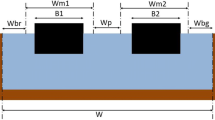Abstract
Simulation of the logistics activities related to the arrival, berthing, service and departure processes of ships in container ports can be carried out for different goals such as design of ship-berth link, increase productivity and efficiency of quay cranes, analysis and planning of operations at the ship-berth link, etc. These logistics activities are particularly complex and very costly since they require the combined use of expensive infrastructure capacities especially berths and quay cranes. Ship-berth link as a main port link is required to serve ships as quickly as possible. Thus, in order to successfully design and develop ship-berth link in a container port and utilise it as efficiently as possible, it is necessary to develop a simulation model that will support decision-making processes of terminal managers. The results, analysis and conclusions given in this paper are intended to provide guidance on achieving time efficiency and accuracy in the modelling of ship-berth link and calibration of ship-berth link simulation models for Pusan East Container Terminal (PECT).










Similar content being viewed by others
References
Demirci, E . 2003: Simulation modelling and analysis of a port investment. Simulation 79: 94–105.
Frankel, GE . 1987: Port Planning and Development. John Wiley and Sons: New York.
Gambardella, LM, Rizzoli, AE and Zaffalon, M . 1998: Simulation and planning of intermodal container terminal. Simulation 71: 107–116.
Hartmann, S . 2004: Generating scenarios for simulation and optimization of container terminal logistics. OR Spectrum 26: 171–192.
Kia, M, Shayan, E and Ghotb, F . 2002: Investigation of port capacity under a new approach by computer simulation. Computers & Industrial Engineering 42: 533–540.
Legato, P and Mazza, RM . 2001: Berth planning and resources optimization at a container terminal via discrete event simulation. European Journal of Operational Research 133: 537–547.
Merkuryeva, G, Merkuryev, Y and Tolujev, J . 2000: Computer simulation and metamodelling of logistics processes at a container terminal. Studies in Informatics and Control 9: 53–59.
Nam, K-C, Kwak, K-S and Yu, M-S . 2002: Simulation study of container terminal performance. Journal of Waterway, Port, Coastal and Ocean Engineering, ASCE 128: 126–132.
Pachakis, D and Kiremidjian, AS . 2003: Ship traffic modeling methodology for ports. Journal of Waterway, Port, Coastal and Ocean Engineering, ASCE 129: 193–202.
PECT. http://www.pect.co.kr.
Schriber, TJ . 1991: An Introduction to Simulation Using GPSS/H. Wiley: New York.
Sgouridis, SP, Makris, D and Angelides, DC . 2003: Simulation analysis for midterm yard planning in container terminal. Journal of Waterway, Port, Coastal and Ocean Engineering, ASCE 129: 178–187.
Shabayek, AA and Yeung, WW . 2002: A simulation model for the Kwai Chung container terminal in Hong Kong. European Journal of Operational Research 140: 1–11.
Steenken, D, Vob, S and Stahlbock, R . 2004: Container terminal operation and operations research – a classification and literature review. OR Spectrum 26: 3–49.
Tahar, MR and Hussain, K . 2000: Simulation and analysis for the Kelang Container Terminal operations. Logistics Information Management 13: 14–20.
Lee, T-W, Park, N-K and Lee, D-W . 2002: Design of simulation system for port resources availability in logistics supply chain. IAME 2002 Panama Conference Proceedings, International Association of Maritime Economist Conference, Panama, 13–15 November 2002. Available at http://www.eclac.cl/transporte/perfil/iame_papers/proceedings/AgendaProceedings.html.
van Asperen, E, Dekker, R, Polman, M and de Swaan Arons, H . 2003: Modeling ship arrivals in ports. In: Chick, S, Sánchez, PJ, Ferrin, D and Morrice, DJ (eds.). Proceedings of the 2003 Winter Simulation Conference. Institute of Electrical and Electronics Engineers (IEEE): Piscataway, NJ, USA. pp. 1737–1744.
Veenstra, AW, Lang, N and van de Rakt, B . 2003: Economic analysis of a container terminal simulation. The International Workshop on Harbour, Maritime & Multimodal Logistics Modeling and Simulation, Maritime Environment II, Riga TU, Latvia, 18–20 September 2003. Available at http://www.eur.nl/fbk/dep/dep1/Introduction/Staff/People/Lang/ia1.pdf.
Vis, IFA and de Koster, R . 2003: Transhipment of containers at a container terminal: an overview. European Journal of Operational Research 147: 1–16.
Yun, WY and Choi, YS . 1999: A simulation model for container-terminal operation analysis using an object-oriented approach. International Journal of Production Economics 59: 221–230.
Acknowledgements
We are grateful to Professor Hercules Haralambides and the referees for their constructive comments and helpful suggestions.
Author information
Authors and Affiliations
Rights and permissions
About this article
Cite this article
Dragović, B., Park, N., Radmilović, Z. et al. Simulation Modelling of Ship-Berth Link With Priority Service. Marit Econ Logist 7, 316–335 (2005). https://doi.org/10.1057/palgrave.mel.9100141
Published:
Issue Date:
DOI: https://doi.org/10.1057/palgrave.mel.9100141




